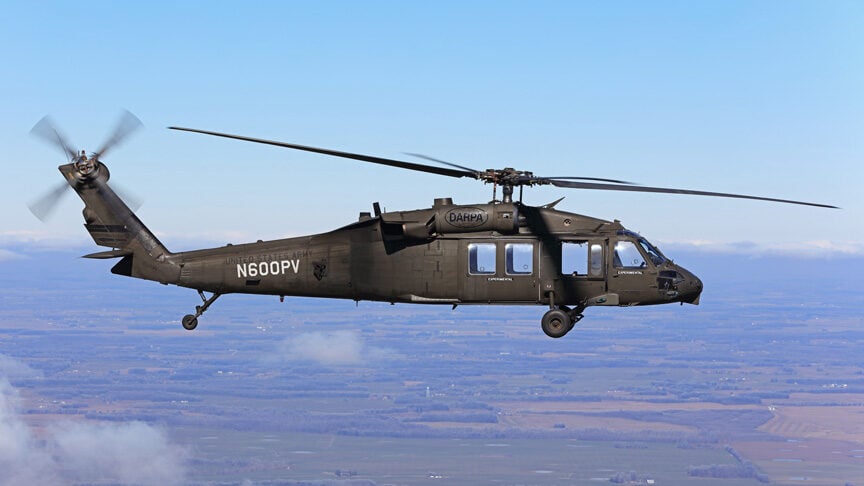
Sikorsky UH-60A Blackhawk during its first unmanned flight at Sabre AHP, Tenn., on Feb. 5, 2022. (Sikorsky)
WASHINGTON — Sikorsky and DARPA officials at this year’s Project Convergence flew what was most likely the final flight of an autonomous system outfitted on a UH-60 Black Hawk, now leaving it up to the Army to determine if it will officially transition the capability into the service, according to a DARPA official.
The Army used the Black Hawk Aircrew Labor In-Cockpit Automation System (ALIAS), which began under DARPA with software developed by Sikorsky to fly the helicopter with no pilot onboard, during last year’s annual sensor-to-shooter campaign and continued to experiment with the program this year.
“You know, this is an old program from a DARPA perspective, but we really feel like we’ve created an inflection point, and it’s a large value proposition,” Stuart Young, DARPA program manager for ALIAS, told reporters Wednesday. “And so we’re really trying to set the conditions at this phase of the program for optimal opportunities for transition to the services and to [the] commercial sector… This is probably our last experiment under the ALIAS program label, but we do have some other opportunities that we’re continuing to pursue with the services on how they can adjust it most effectively.”
During this year’s Project Convergence demo in October at Yuma Proving Ground, Ariz., pilots flew and landed a Black Hawk before activating Sikorsky’s MATRIX autonomy system, a key component of ALIAS, to perform three missions without a pilot on board. According to a Nov. 2 Sikorsky press release, one of those was a medical exercise in which the helicopter flew 83 miles with 500 pounds of real and simulated blood. Another involved a human operator interrupting a heavy-load supply flight mid-mission to redirect the chopper for a simulated casualty evacuation. Video of that mission, published by Sikorsky parent company Lockheed Martin, showed two people loading a dummy on a stretcher into the pilotless Black Hawk before it took off again.
“Once the manikin on a litter was secured inside the cabin, the ground operator launched the aircraft. During the return flight, a BATDOK [Battlefield Assisted Trauma Distributed Observation Kit] health monitoring device integrated with the helicopter’s communications system relayed the patient’s vitals in real-time to a ground-based medical team,” according to the press release.
Sikorsky Innovations Director Igor Cherepinsky told reporters Wednesday that the ALIAS Black Hawk could work on regular schedule for whoever wants it next.
“So in the case of the Black Hawk, we developed a concept we call ‘eight, eight and eight,’ where you have eight hours of manned operation of the aircraft with crews, then as those crews are resting you have eight hours of uninhabited, uncrewed operation where the aircraft pulling loads doing whatever needs to be done,” Cherepinsky said. “And then you have…the remaining eight hours for maintenance that needs to happen.”
As for whether the Army or other military services will adopt the autonomous technology, Young said he’s “very confident” but “the question has to do in what form or fashion.”
“And so as we deal with the acquisition process, there’s certainly things that we have to overcome,” he continued. “But the overwhelming response from the services is that this has opened their eyes to what is truly possible now and is causing them to rethink the capabilities that they can imagine with this technology. So I’m very confident that it’ll happen.”




















